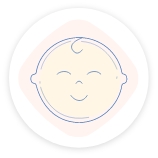
Your baby has been talking to you since they were born. Well, not exactly with words, but with the language of babies: gurgles, babbles, cries, moans, arches, waves, grimaces and more. Understanding this special language is the key to helping meet your baby’s everyday needs, from “Feed me, I’m hungry!” to “Change me, I’ve got a poopy diaper!”
Unfortunately, sometimes parents get confused about what their baby is trying to tell them and may mistake discomfort or tiredness as hunger. In a 2010 Academic Pediatrics study, 72% of mothers surveyed believed that a crying baby meant a hungry baby.
